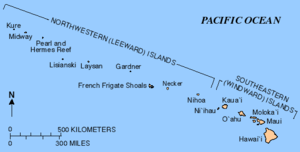Naval Air Facility Midway Island
| Naval Air Facility Midway Island | |
|---|---|
| NAS Midway | |
| Midway Atoll in United States | |
|
Midway Atoll, showing NAS Midway runways and their remnants. | |
 Midway is at the far northwest end of the Hawaiian archipelago. (Click to expand) | |
| Type | Air Facility |
| Site information | |
| Owner | US Navy |
| Site history | |
| Built | 1941 |
| In use | October 1, 1993 |
| Fate | Closed |
| Battles/wars | Battle of Midway |
Naval Air Station Midway Island, also known as NAS Midway, Naval Air Facility Midway, and NAF Midway (former ICAO PMDY), was a U.S. Naval Air Station in the Midway Atoll, the northernmost group of the Hawaiian archipelago. It was in operation from 1941 to 1993, and played an important role in trans-Pacific aviation during those years. Through its lifetime, the facility was variously designated as a Naval Air Station, a Naval Air Facility, and a naval base. It was finally closed on 1 October 1993.[1]
Midway Atoll consists of two small islets, Sand Island and Eastern Island, surrounded by a coral reef. Most of each islet is taken up by airfields. The islands were discovered in 1859, and placed under Navy control by President Theodore Roosevelt in 1903. They gained importance in the mid-1930s as a seaplane stop for the Pan American Airways Clipper planes. A Navy presence then began building up, and Naval Air Station Midway Islands was established on Eastern Island in August 1941.[1]
On 7 December of that year, the base was bombarded by Japanese surface ships as part of the attack on Pearl Harbor. This was followed by a major buildup of U.S. Navy, Marine, and Army Air Corps squadrons, meant to detect and defeat units of the Japanese fleet. In late 1942, the Japanese attempted to invade the islands and destroy the nearby U.S. carrier task forces. From 4–7 June, the Battle of Midway resulted in damage to most of the base, but Navy carrier aircraft sank four Japanese aircraft carriers and one cruiser. This became the turning point of the war in the Pacific.[1]
After the Battle of Midway, a second airfield was developed, this one on Sand Island. This work necessitated enlarging the size of the island thru land fill techniques, that when concluded, more than doubled the size of the island. It became an important stopover for planes heading to the war zone. It was the origin of a long-range strike on Wake Island by PB2Y Coronados, and was also used for the submarine war patrols that devastated Japanese shipping.
Activity diminished after the war, and Eastern Island was abandoned in 1945. The base was placed in caretaker status and the Naval Air Station was disestablished on 1 August 1950. It was reestablished as a Naval Air Facility Midway in July 1958, serving as a deployment sire for land-based Navy EC-121 Warning Star (later redesignated EC-121 "Warning Star") aircraft performing airborne early warning Barrier Combat Air Patrol (BARCAP) missions. During the mid-1960s, NAF Midway became an important stop for transport aircraft moving to and from Vietnam, and the base was redesignated as a full Naval Air Station. In 1970, Eastern Island was once again vacated, this time being designated as a wildlife sanctuary. After the Vietnam War, NAS Midway mainly served as a refueling stop and a base for occasional Navy patrol planes. In October 1978 it was again downgraded to Naval Air Facility status and all military dependents were sent home to Hawaii while military personnel cycled through on either unaccompanied remote or short duration assignments. With the end of the Cold War, operations dwindled even more. NAF Midway was disestablished pursuant to BRAC on 1 October 1993.[1]
After its closure as a naval installation, the airfield reopened as civilian airport under the name Henderson Field.
References
- 1 2 3 4 "NAF Midway" (PDF). Naval Aviation News. 76 (5): 11. 1994-07-01. Retrieved 2014-01-30.